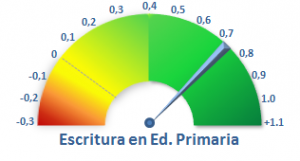Implementing institution: Calderdale Excellence Partnership (CEP) – Durham University
Country: United Kingdom
Source: Education Endowment Foundation
Execution period: 2012 - 2014
Plataforma de Prácticas Efectivas:
To strengthen the writing skills of students in transition from elementary to secondary education.
A program of memorable recreational experiences, during which self-regulation is encouraged.
The activities allow participants to increase their writing skills by 0.74 SD, but do not have a significant effect on reading skills.
The Using Self-Regulation to Improve Writing strategy is part of a larger program of 23 projects aimed at increasing the writing skills of children in transition between elementary and secondary education. With funding from the Education Endowment Foundation (EEF), 23 schools located in western Yorkshire have formed the Calderdale Excellence Partnership to implement the Self-Regulated Strategy Development (SRSD) practice.
The goal of the SRSD methodology is to give students the tools they need to write, while supporting them to keep them motivated. It is a model of writing assistance, in which the student is encouraged to plan, write, edit and revise what he or she has written, always in relation to memorable experiences. The practice is developed through 6 steps: delivering the appropriate knowledge in relation to the characteristics of each student; discussing with students in a feedback process; defining a writing model; memorizing it; guiding students in their note-taking; and leaving enough space for independent work.
Memorable recreational activities that give rise to writing practice include visits to castles, historic buildings, and personal stories. In order for teachers to take ownership of the SRSD methodology and apply it in the best way, the intervention includes training in small groups. At the end of the year, the participating teachers meet to discuss their experiences and collectively identify the strengths and weaknesses of the program.
In England, the enrolment of children at elementary and secondary level covers almost the entire population of attendance age (99.85% and 98.28% respectively by 2014). Net participation rates have been growing since 2006, especially at the secondary level (+6 percentage points). However, in 2013, around 85,000 pupils left elementary school without having passed the national writing tests (Department of Education, 2013). This indicates poor teaching performance in this area.
Between 2013 and 2014, York University and Durham University have evaluated Self-Regulated Strategy Development (SRSD) in order to assess its effectiveness in increasing writing ability. A pilot evaluation was conducted in 23 elementary schools, of which only 11 received the SRSD program.
All children were tested at the beginning and end of the intervention, using a test developed by GL Assessment. Comparison of results at the end of the intervention has shown a very high impact (+0.74 SD) of the SRSD strategy on the improvement of children’s writing in elementary education. However, it had no significant effect on grammar, reading or spelling skills. Therefore, the evaluation team has recommended to corroborate the results with another study to ensure the mentioned impact. Given its low costs (£52 per student per year), covering both visits and teacher training, the SRSD strategy represents a promising innovation that could be replicated elsewhere to counter children’s weaknesses in writing.

Charts: Impact measured in standard deviations of the intervention group compared to the control group.
Link: https://educationendowmentfoundation.org.uk/projects-and-evaluation/projects/ipeell/
Report: Ver informe
Other documents: Escritura-en-ed-primaria-e1499784876426.pngDurham-University-Logo--e1499784754134.jpg
Tags: